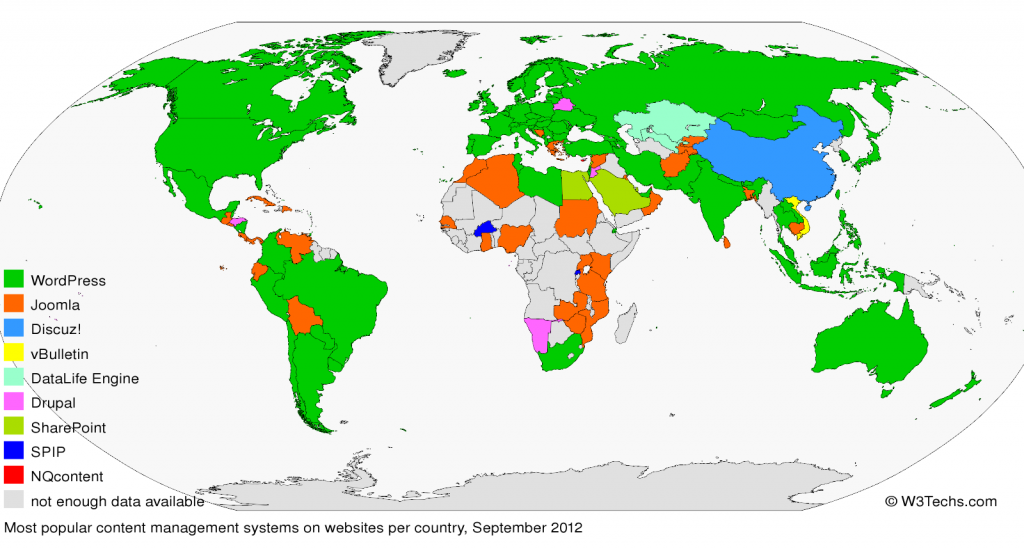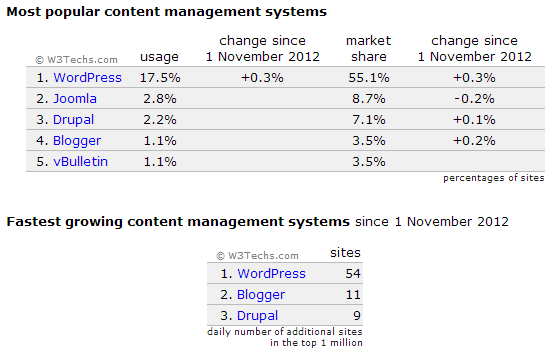What is the best CMS (Content Management System)?

A CMS (Content Management System) is a complete website-solution, that makes you able to build a professional website, without learning programming, but instead you can focus on building high-quality content. You install the CMS on your FTP-server and then you build the website by installing various modules, plugins and themes for your CMS. For the most-used CMS, there exist a lot of different, free modules, plugins and themes you can install – but you can also buy some cheap, if you need something more.
There exist very many different CMS, the Top 3 is: WordPress, Joomla and Drupal. In this article we will look on the difference on the different CMS and when you should use which CMS.
WordPress
WordPress is the most used CMS in the world (see the map below from W3Techs). The map shows which CMS that are most used in which country. The green represents WordPress, The orange Joomla and the pink Drupal. There are no doubt that WordPress is the most used system in most countries.
From W3Techs, you can also see the latest overview over market share among CMS in the world. As you can see WordPress has a market share of 55,1%, where Joomla have only 8,7% and Drupal only 7,1%. WordPress has the biggest increase in market share at the moment (0,3% in a month). So WordPress isn’t only the CMS that has the biggest market share, but also the CMS with the biggest increase in market share.
But why is WordPress so popular? It was first released back in 2003 by Matt Mullenweg. Since then it has come to version 3.5, that has been released recently. WordPress is a blogging-CMS and was build for blogging, although you through themes and plugins can build WordPress so it looks like an ordinary website.
It exist in two versions, a self-hosting version you can download and install on your own host or a free-hosted version. The free-hosted version is easy to start with, partly because you don’t have to own your own host and partly because it is already installed. The disadvantage is that there is limitations in this version: You cannot install your own plugins, you cannot install your own themes and you are not aloud to place your own advertising on the sites. This means you cannot customize it as you like and you cannot earn money on the website. Some plugins that would be good to have installed, but you cannot in the hosted version, is plugin for Google Analytics and plugins for showing ads. In the self-hosted version you can install all plugins and themes as you like.
WordPress is very easy to start with. It is very streamlined in the structure and almost never crashes. The privileges is very easy to control (however it is not easy to add more privileges), security is in top, the design is nice and most important of all: SEO (Search Engine Optimization) is very implemented, so you from the start get a high place in search engines. There is build-in-pinging which means the site is easily spread around the world.
The disadvantage of WordPress is that there is not so many build in settings on pages, posts, users etc. as you can find in Joomla. Therefore you cannot control the structure fully very easy with WordPress, as you can in Joomla. However this will only be a problem for about 1%, because for most users the structure of WordPress works fine.
WordPress is very easy to update, it actually almost happens automatically – something Joomla and Drupal can learn from. Actually they also have update-functions, but they don’t work so automatically and smooth as WordPress’ update-section. This means that when you use WordPress, you can be sure to always have updated CMS and updated themes and plugins. We can also from the table below see, that almost all WordPress users is updated (table comes from W3Techs):
You can download WordPress from here and get a free hosted version here. An example of a WordPress site is this blog – it is build from WordPress 3.5.
Joomla
Joomla was released in 2005, from another CMS called Mambo. As WordPress you can also install a lot of addons and themes. Where you can only install addons in the form of plugins in WordPress, you can also do it as modules and components in Joomla.
Joomla has recently been releasing version 3 for betatest. Version 3 has a lot of change in the design, and maybe this version will lead to growth of market share of Joomla. Joomla has been criticized for having too big, ugly icons in the admin section. This is over in version 3, where the icons is replaced by a beautiful topmenu.
Joomla is also very easy to start with and there is many very good plugins and modules you can install. It is very easy to setup privileges for Joomla, and the security is in top.
You can download Joomla for free from this site. An example of a Joomla-site is one of my other, danish sites: Apandersen.dk, if you will take a look.
Drupal
Drupal is the CMS for geeks, cause it isn’t easy to start with, although they are getting better. It started in 2001, where the first version was released. It started as a messageboard, written by Dries Buytaert. As with Joomla and WordPress, you can install addons called core modules and core themes for Drupal.
Something different for Drupal is that there exist distributions, just like linux distributions. These are finished, packed version of Drupal including core packages. This makes it easier for people to start with Drupal.
Drupal might be the system with the highest learning curve, but the benefit is that you can customize it much more as you want it. This benefits a lot of sites, as magazines and government sites. But Drupal might not be the place you should start, if you haven’t tried any CMS before. The usability is not very easy with Drupal, because the interface is very confusing. And the biggest problem for Drupal is that the developers don’t see the problem as big as the customers.
Drupal can be downloaded from here.
Blogger
Blogger is also a CMS delivered by Google. You cannot download and host it yourself, but it is completely free. It is the 5. most popular CMS and actually the 2. most growing CMS in market share.
Other CMS
WordPress, Joomla and Drupal is the biggest CMS you can get. But there exist a lot of other CMS. Here are some of them:
Discuz! – the biggest CMS in China
vBulletin – the 5. most popular CMS
Datalife Engine
Sharepoint
SPIP
NQcontent







